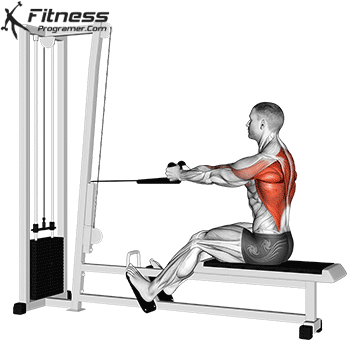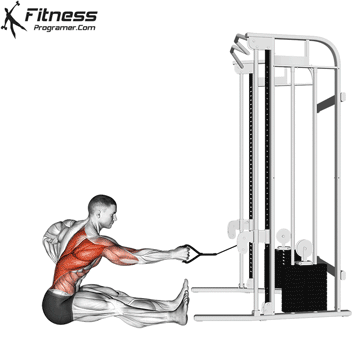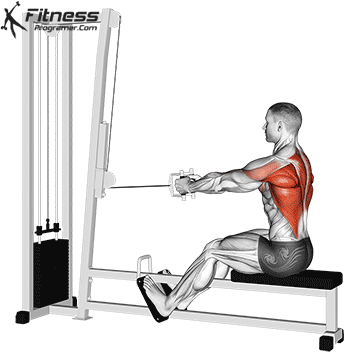Seated Cable Row
The seated cable row is a popular cable exercise that targets the upper back and lats. This exercise involves pulling a cable attachment towards your body while seated, using a cable machine. Whether you’re a beginner or an experienced lifter, this exercise can be a valuable addition to your training program.
How to do:

Proper posture is essential when performing the seated cable row to ensure that the exercise is effective and to prevent injury. By following these tips, you can maintain proper posture and perform the seated cable row safely and effectively.
Seated Cable Row Instructions:
- Place your feet firmly on the footrest or platform provided by the cable machine.
- Keep your back straight and avoid slouching or rounding your shoulders forward. Engage your core muscles to help maintain good posture. This will help you maintain stability and prevent your lower back from rounding.
- Before starting the exercise, retract your shoulder blades and keep them in this position throughout the movement. This will help engage the muscles of the upper back and prevent excessive strain on the shoulders and neck.
- As you pull the cable handles towards you, keep your elbows flared out to the sides and squeeze your shoulder blades together at the end of the movement. This will help engage the muscles of the upper back and prevent excessive strain on the shoulders.
- Pause for a second at the top of the movement and then slowly release back to the starting position. Exhale as you pull the cable towards your body and inhale as you return to the starting position.
- Repeat for the desired number of repetitions.
Tips:
- Rounding the back: Maintain proper posture throughout the movement by keeping your back straight and your chest up.
- Using too much weight: Start with a lighter weight and gradually increase as you become more comfortable with the exercise.
- Using momentum: Focus on using a slow and controlled movement to engage the target muscles effectively.
Attachments You Can Use For Cable Rows
Seated cable rows can be performed with a variety of attachments, including wide-grip handles, close-grip handles, rope, stirrup and v-bars. This makes them a versatile exercise that can be customized to target different muscle groups and provide a range of benefits.
Incorporating these attachments into your cable row workout routine can help you target specific muscle groups and achieve maximum results. Each attachment provides a unique challenge and can help you to build overall back strength, improve your posture and prevent injuries.
Straight bar: The straight bar is a popular attachment for cable rows and is designed to target the lat muscles. By using a wide grip, you can increase the range of motion and engage the lats more effectively.
Close-grip handle: The close-grip handle is an attachment that can help target the mid-back muscles and increase the overall intensity of the exercise. By bringing your hands close together, you can engage the rhomboid muscles and build upper back strength.
Rope attachment: The rope attachment is a variation of the cable row that can help to target the rear deltoids and improve overall shoulder strength. By using a rope, you can increase the range of motion and engage the shoulder muscles more effectively.

Single Stirrup Handle: The single-arm handle is a popular attachment that can help to isolate one side of the back at a time. By using a single handle attachment, you can perform the exercise one arm at a time and ensure that each side is getting an equal workout.
 V-Grip Handle: The V-shaped design of the handle provides a more natural grip, which can improve wrist alignment and reduce stress on the joints. This can be especially beneficial for those who have wrist or elbow pain with other types of grips.
V-Grip Handle: The V-shaped design of the handle provides a more natural grip, which can improve wrist alignment and reduce stress on the joints. This can be especially beneficial for those who have wrist or elbow pain with other types of grips.

Many of the movements that work the same muscle group can be similar, but because they are done at different angles, they may be more effective on previously untrained areas of the muscles. For this reason, remember that it would be more beneficial to include different angles and grip positions in your training program.
Seated Cable Row Benefits
- Increased muscle mass: It is one of the most effective exercises when it comes to back muscles. Allows you to build both the width and thickness of the back simultaneously. Cable movements provide constant tension throughout the entire movement. Using cables allows you to work both the concentric and eccentric portions of the exercise. More tension equals more muscle activation.
- Increased upper body strength: Having a strong back helps to keep the spinal column in proper alignment and allows for completion of everyday tasks with reduced injury risk. In addition to helping strengthen the back, the exercise secondarily works the arms and shoulders.
- Improved posture: Seated cable rows are a good choice for individuals who are looking to target the upper and middle back muscles while minimizing stress on the lower back. This exercise may also be a good choice for those who are new to strength training or have limited mobility, as the use of a cable machine allows for a greater range of motion and more control over the resistance. Finally, seated cable rows are a great choice for those who are looking to improve their posture, as they engage the muscles responsible for maintaining a strong and stable upper back.
Seated Cable Row – Muscles Worked
This exercise targets the muscles of the upper and mid-back, including the latissimus dorsi, posterior deltoid, rhomboids, and trapezius. Here are all the muscle groups involved in the seated cable row exercise:

